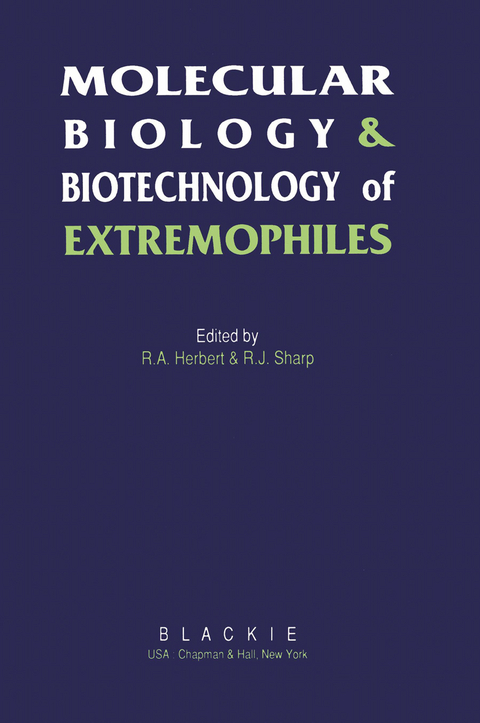
Molecular Biology and Biotechnology of Extremophiles
Springer (Verlag)
978-94-010-5009-8 (ISBN)
It is now well recognised that many environments considered by man to be extreme are colonised by micro-organisms which are specifically adapted to these ecological niches. These organisms not only survive but actively grow under such conditions. A diverse range of bacteria, cyanobacteria, algae and yeasts has now been isolated from these habitats which are extreme in terms oftemperature, pH, salinity and pressure as well as species which are resistant to radiation and toxic chemicals. Whilst originally considered to be mere 'scientific curiosities', it is now generally accepted that many have con siderable biotechnological and commercial significance. Recently the term 'extremophile' has been used to describe these organisms. Over the past twenty years extensive studies of the ecology, physiology, taxonomy and molecular biology of these micro-organisms have been undertaken. These have resulted in a complete reassessment of our concept ofmicrobial evolution. The identification ofthe Archaeobacteria as the third kingdom ofliving organisms has given considerable impetus to extremophile research and is presenting many new challenges.
1 Biochemistry and molecular biology of the extremely thermophilic archaeobacteria.- 1.1 Introduction.- 1.2 Archaeobacterial phylogeny.- 1.3 Ecology of the thermophilic Archaea.- References.- 2 The molecular genetics and biotechnological application of enzymes from extremely thermophilic eubacteria.- 2.1 Introduction.- 2.2 Aerobic eubacteria.- 2.3 Anaerobic eubacteria.- 2.4 Other enzymes from anaerobic thermophiles.- References.- 3 Biotechnological prospects for halophiles and halotolerant micro-organisms.- 3.1 Introduction.- 3.2 Micro-organisms in the food industry.- 3.3 Production of commercially useful compounds.- 3.4 Future aspects.- References.- 4 Acidophilic bacteria: adaptations and applications.- 4.1 Introduction.- 4.2 Constraints on growth at acid pH.- 4.3 The diversity of the extreme acidophiles.- 4.4 The bacterial extraction of metals from mineral sulphides.- 4.5 Molecular genetic studies of acidophiles.- 4.6 Concluding comments: diversity, identification and applied molecular biology.- References.- 5 Alkaliphiles: ecology and biotechnological applications.- 5.1 Introduction.- 5.2 Alkaliphiles and industry.- References.- 6 Physiology and biotechnological potential of deep-sea bacteria.- 6.1 Introduction.- 6.2 Deep-sea bacteria.- 6.3 Hydrothermal vents.- 6.4 Biotechnology of deep-sea bacteria.- References.- 7 Physiology and molecular biology of psychrophilic micro-organisms.- 7.1 What are psychrophiles and psychrotrophs?.- 7.2 Microbial types of psychrophiles.- 7.3 Ecology of psychrophiles and psychrotrophs.- 7.4 Molecular mechanisms of adaptation to low temperature.- 7.5 Biotechnological uses and potential of psychrophiles.- References.- 8 Molecular biology and biotechnology of microbial interactions with organic and inorganic heavy metal compounds.- 8.1 Introduction.- 8.2 Physiology of metal-microbe interactions.- 8.3 Molecular biology of heavy metal tolerance.- 8.4 Biotechnological aspects of metal-microbe interactions.- References.- 9 Molecular biology of radiation-resistant bacteria.- 9.1 Introduction.- 9.2 Types of radiation.- 9.3 Radiation resistance of bacterial species.- 9.4 Repair of radiation damage: mutation rates and mutagens.- 9.5 The biology of the Deinobacteriaceae.- 9.6 Shuttle plasmids between D. radiodurans and E. coli.- 9.7 Gene expression in the deinococci.- 9.8 Prospects in molecular biology.- 9.9 Biotechnology of the deinococci.- 9.10 Prospects for biotechnology.- References.- 10 Obligate anaerobes and their biotechnological potential.- 10.1 Introduction.- 10.2 The industrial exploitation of anaerobic fermentations.- 10.3 Anaerobic disposal of organic wastes.- 10.4 Anaerobic biotransformations.- 10.5 Anaerobic enzymes as industrial products.- 10.6 Molecular genetics of anaerobic bacteria.- References.- Species index.
Aims to provide a compresensive review of the current understanding of the meachanisms that extremophiles hav evolved to survive and grow in particular extreme environments, and how these may be exploited for biotechnological processes. - British Book News; This is essential reading for anyone working with these unusual and at times exasperating organisms...This is an excellent book which should find favour with experienced research workers, post-graduates, undergraduates and those of us who teach in these areas. Society for General Microbiology Quarterly
| Zusatzinfo | XII, 331 p. |
|---|---|
| Verlagsort | Dordrecht |
| Sprache | englisch |
| Maße | 152 x 229 mm |
| Themenwelt | Naturwissenschaften ► Biologie ► Evolution |
| Naturwissenschaften ► Biologie ► Zoologie | |
| ISBN-10 | 94-010-5009-0 / 9401050090 |
| ISBN-13 | 978-94-010-5009-8 / 9789401050098 |
| Zustand | Neuware |
| Haben Sie eine Frage zum Produkt? |
aus dem Bereich


